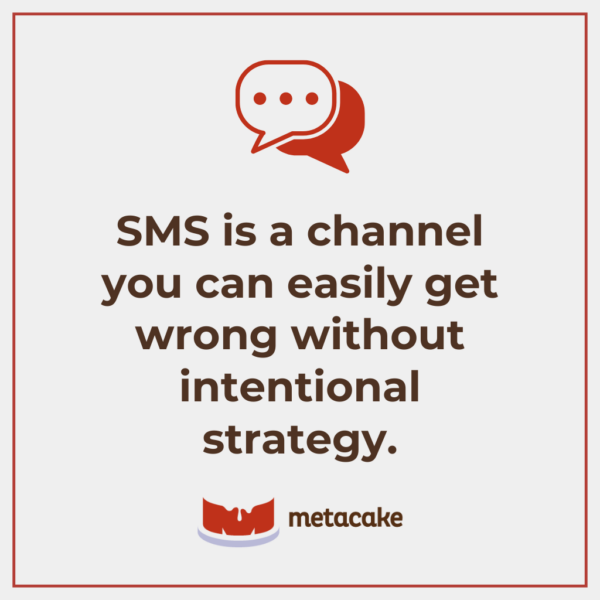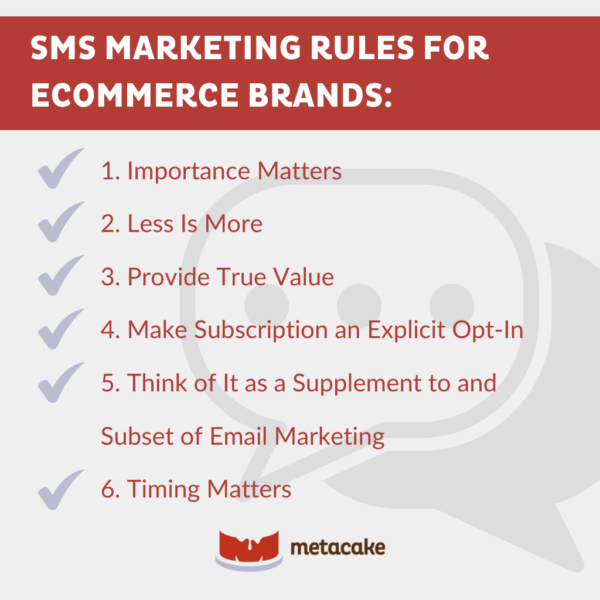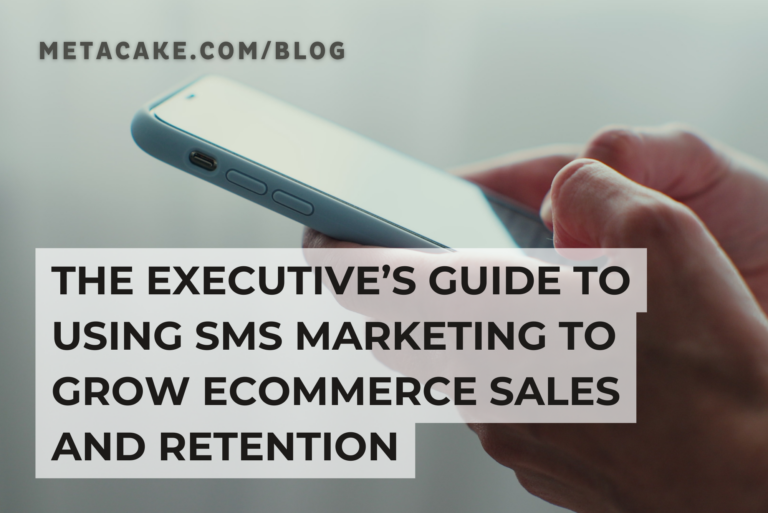In the ecommerce space, SMS marketing has quickly shifted from a novel concept to a marketing essential. But not all ecommerce businesses have fully bought into its importance or taken the leap to get started.
With its low cost and high engagement rate, this channel has the ability to add multiples to your marketing strategy. After all, on average, people check their phones more than 80 times per day.
However, SMS is a channel you can easily get wrong without intentional strategy. You’ll need to follow best practices to respect customers’ space and keep them happy and engaged (instead of annoyed and unsubscribed).
In this post, we’ll give an overview of SMS marketing for ecommerce and some rules for getting it right in your business.

SMS Marketing for Ecommerce: How Does It Work?
SMS marketing works much like email marketing, but messages are delivered via text message to the customer’s phone rather than over email.
The important thing to note is that, like email, SMS is an “owned” channel and therefore much different than PPC. With traditional PPC advertising, like on Google or Facebook, the customers you’re marketing to aren’t your own. You’re also at the mercy of the advertising platform and all their rules, algorithm changes, privacy regulations, and potential account shutdowns.
With owned marketing through email and SMS, you’re in control. You’re the one building a customer list that adds value to your business, creating relationships, building brand fans, and increasing revenue as a result. Facebook and Google ads have their place, but without owned channels, you won’t be able to build a healthy, profitable business.
Benefits for Your Brand (and Your Customers)
Statistics make it clear that ecommerce shoppers regularly engage with SMS marketing — and some even prefer it. Let’s check out a few things you might not have known about the benefits of texting with customers.
Convenience
According to OptiMonk, 71% of Shopify orders come from mobile. Meeting the majority of your customers where they are — on their phones — is convenient for the customer and effective for you.
High Visibility
Research indicates that texts have a 99% open rate. This offers much higher visibility than email, where the open rate falls within the 12–25% range.
Strong Engagement
According to Postscript.io, 98% of texts are read by the end of each day, and 32% of consumers respond to texts from a brand. This is different from email marketing, where a 20% open rate and a 2% click rate are the average.

SMS Marketing Rules for Ecommerce Brands
Now that we’ve covered the benefits of SMS marketing, let’s outline a few ground rules. As we mentioned earlier in the post, SMS can be highly effective, but it must be done well in order to maintain customers’ trust and engagement. Here are the most valuable rules to follow when getting started with SMS.
1. Importance Matters
Don’t send text campaigns about anything and everything. SMS should only be used for messages that are urgent or have a clear call to action.
For example, announcing a new product with a limited quantity or a promotion you’re running are great opportunities to text your customers. If it doesn’t feel particularly exciting, time-sensitive, or urgent, send it over email, saving the top 10% of your messages for text.
2. Less Is More
It may seem counterintuitive, but less is more with SMS marketing — for both your customer list and the content you send.
On the list side, focus on building a quality list of names. You want a list of explicit opt-ins — and it’s even better if they opted in for a specific reason so they know exactly what to expect from you.
As for content, you’ll need to strike a balance of texting customers enough that they’re accustomed to receiving valuable texts from you but not so much that they get tired of it. Your best bet is to focus on sending fewer, more impactful texts.
3. Provide True Value
Think of each message as having a value assigned to it for the customer.
Craft texts that are concise, with an offer or call to action that feels valuable enough to interrupt whatever the customer is doing (in a work meeting, at dinner with their family, at the gym, etc.). We’ve all experienced the irritation that comes from receiving a notification that you didn’t actually need to know about, so don’t do that to your customers. The more value your message has, the less annoying the interruption will feel.
For example, maybe a product on their wish list just dropped in price or a product they wanted is now back in stock. Maybe you’re running a flash sale just for the weekend or you’re offering SMS subscribers early access to the biggest sale of the year. Experiment with different types of offers to build your brand and keep customers interested.
4. Make Subscription an Explicit Opt-In
As we mentioned when talking about your SMS customer list, be intentional with how you acquire those phone numbers. You want people who want to get messages from you, ideally about a specific topic. On your SMS sign-up form, mention what customers can expect, such as early access to promotions, notifications when items of their choice are back in stock, shipping notifications, etc.
5. Think of It as a Supplement to and Subset of Email Marketing
SMS marketing for ecommerce doesn’t replace email, but it can enhance your efforts. If you position SMS so it falls underneath your email strategy as a supplement and subset for it, it becomes easy to determine which messages are good for SMS and how to keep your frequency low.
For example, your email marketing should do the majority of the heavy lifting during your Black Friday and Cyber Monday sales. But you can use SMS to help announce when the sale is live, any new deals that pop up, or a reminder when the sale’s about to end.
Note: If you don’t have a thriving, revenue-generating email marketing strategy, this should be a priority ASAP. Check out our six-part, in-depth guide for email marketing to get yours started today.
6. Timing Matters
SMS marketing is unique — it interrupts your customers wherever they are. Emails sit in customers’ inboxes until they check their email, and even app notifications can be silenced. Since texts behave differently, it’s important to consider timing based on the customer’s time zone, lifestyle, and the general calendar. This consideration can be the difference between campaign failure and success.
Here are a few timing-related elements to keep in mind:
Time Zone
Schedule texts in your customer’s time zone, not your own. Platforms like Klaviyo have this feature and make it easy to set up.
Customer’s Lifestyle
Are your customers mainly stay-at-home moms, full-time office employees, or retired? People in different life stages have different schedules, so if your customers fall into one niche, it can be helpful to take this into account.
Context During Holidays
Ecommerce promotions often fall on holidays — Memorial Day, Labor Day, Black Friday, etc. These are weekends when customers can be busy, out of town, or enjoying time with their families. Be a brand that cares about the lives of your customers and takes the time of day into account.
You can even use this context to make messages more personal. For example, on Thanksgiving, wait until the later evening to reach out with a message like, “Now that Thanksgiving dishes are done and you can put your feet up, be sure to use this link for early VIP access to our Black Friday sale going on now!”
When and Where to Use SMS Marketing for Ecommerce
We’ve talked a lot about the importance of keeping SMS marketing intentional and valuable for your customers. Now we can get more specific with inspiration for when and where to incorporate SMS marketing in your channel mix.
Here are a few specific scenarios where offering an SMS opt-in could be valuable for your customers:
- Promotions: If you have a sale coming up or currently running, create an SMS opt-in for customers to get notified when the sale goes live or get “exclusive access” to the sale. You could also make a note of products that are going fast or potential price increases.
- New Products: Encourage customers to sign up to be notified when new products are released. You could also tailor this opt-in further and offer it to segments of customers who purchased a related product.
- Brand Content: There can be cases where customers sign up for SMS notifications when you release new content. Just be sure to use SMS sparingly for this and always add value.
- Back-in-Stock Notifications: If you have a “Notify Me When Available” option on your product pages, why not link it to SMS in addition to your email platform? This is especially helpful if the product quantity is limited and customers want to be alerted about availability immediately.
- Price Drops: Notify customers when items on their wish list or in their cart are on sale or dropped in price so they can jump on the deal.
- Gathering Feedback: This should be done cautiously, but when it’s done right, SMS can be a great way to gather customer feedback and reviews.
- Shipping Notifications and Other Logistics: This is usually offered at checkout so customers can track their order’s shipping and get other updates to their phone.
- Customer Service Communication: This isn’t as common yet, but some brands have started using SMS as a way for customers to talk with the customer service team about questions or problems.
Starting to Integrate SMS Into Your Marketing
If you’re looking to start with SMS in your ecommerce marketing but aren’t sure how, start small.
Create a simple entry pop-up on your homepage or an opt-in at checkout, and begin building your list. Have conversations with your marketing team about what’s most important to send via text and what could be fine to send over email. Test different offers and messaging on your opt-in form, and experiment with the types of texts you send to see what your customers value most.
Recommended SMS Tools for Ecommerce Marketing
Our top recommendation for SMS marketing for ecommerce is Klaviyo — also our top choice for email marketing. Klaviyo makes integrating SMS into your marketing communication simple. They have direct integration with Shopify, and if you’re already using Klaviyo for email, it makes sense to have all your customer’s contact info in one place.
Another SMS platform to consider is Emotive. This software offers conversational text message marketing for you and your customers, so it’s more of an interactive, personalized experience than standard texts. Emotive integrates with Shopify and Klaviyo as well, so customer data can be shared across all platforms.
Ready to Grow Ecommerce Sales and Lifetime Value With SMS Marketing?
If you’re looking for ways to increase revenue in a way that’s actually profitable, owned marketing channels are a must. SMS can be a valuable addition to email marketing and can integrate seamlessly with platforms you’re already using.
If you’re a brand and want to build customer relationships and increase your revenue using more owned channels rather than paying for PPC advertising, contact us today. Our team of experts is ready to help you grow your SMS and email marketing channels.
